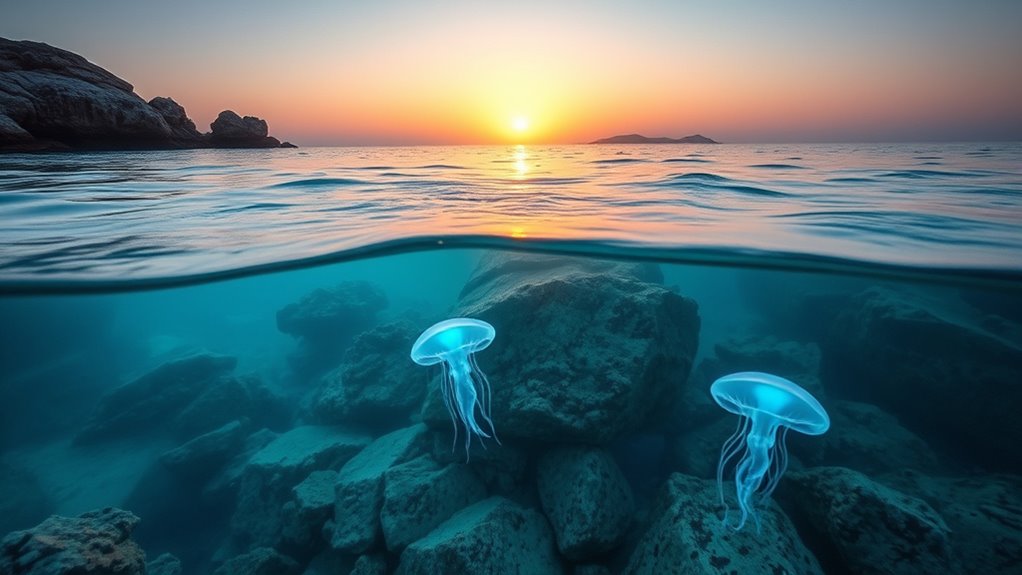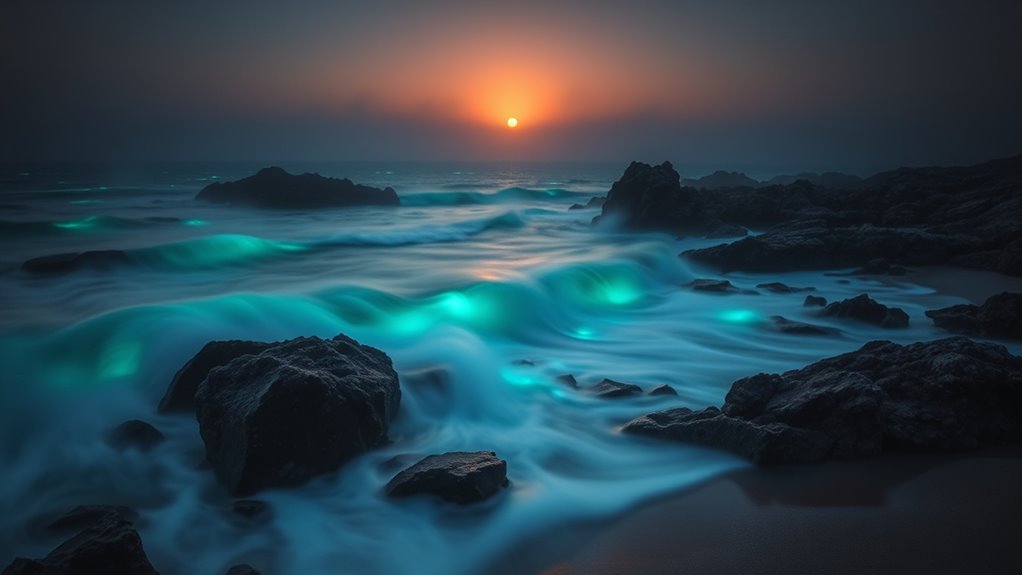The enchanting voices blamed on sirens in the Aegean Sea actually stem from natural acoustic phenomena. Environmental factors like water temperature, wind, and underwater terrain bend and reflect sound waves, creating illusions of distant, alluring melodies. These natural distortions trick sailors into believing they hear supernatural voices, fueling myth and legend. If you explore further, you’ll uncover how these fascinating natural effects shaped the stories that continue to captivate people’s imaginations.
Key Takeaways
- Natural acoustic phenomena, influenced by sea conditions, create illusions of distant, enchanting sounds mistaken for siren calls.
- Environmental factors like underwater topography and temperature affect sound travel, producing echoes and amplifications.
- These natural sound distortions historically led sailors to perceive voices from unseen sources, fueling siren legends.
- Mythological sirens may have originated from these natural acoustic illusions, blending natural phenomena with human imagination.
- Modern science explains these illusions through the physics of sound, enhancing understanding of the sea’s mysterious allure.

Many believe that the legendary sirens of the Aegean Sea were mythological creatures whose enchanting songs lured sailors to their doom. However, these stories may stem from natural phenomena that created powerful acoustic illusions, fueling maritime legends over centuries. Instead of mythical beings, what you’re likely experiencing are the effects of unique environmental conditions that distort sound and deceive the human ear. These acoustic illusions can make distant sounds seem closer or more alluring than they truly are, leading sailors astray and inspiring stories of sirens singing from the rocks.
Natural acoustic illusions in the Aegean often explain siren legends and distant enchanting sounds.
In the open waters of the Aegean, the way sound travels is heavily influenced by the sea’s temperature, wind patterns, and underwater topography. These factors can bend and reflect sound waves, creating echoes and amplifications that seem to come from nowhere. When you’re oriented these waters, you might hear a melody or call that appears to originate from a specific point, yet there’s no actual source nearby. This phenomenon is a classic example of how environmental conditions generate acoustic illusions, which sailors historically mistook for the siren’s song. The natural acoustic effects in the region make it seem as if voices are echoing from the cliffs or submerged rocks, reinforcing maritime legends of seductive sirens.
The idea of sirens as mythological creatures might have grown from these very illusions. Sailors, hearing these mysterious sounds, would have believed they were hearing divine or supernatural voices. Over time, stories grew more elaborate, blending real natural phenomena with imagination and fear. These maritime legends served as warnings about the dangers of the sea, but they also captured the human desire to explain the unexplainable. Today, scientists understand that much of what was once attributed to magical beings can be explained by the physics of sound and the environment.
Understanding the natural origins of these phenomena doesn’t diminish their mystery but adds a layer of scientific wonder to the stories. When you’re near the Aegean, it’s important to recognize that the enchanting melodies might not be supernatural but the result of complex acoustic illusions created by nature itself. These phenomena remind you that the sea’s beauty and danger often lie not just in what you see but in what you hear. The true “sirens” are the natural forces that manipulate sound in ways our ancestors could hardly imagine, weaving maritime legends that persist even today. Additionally, advances in environmental acoustics help scientists better understand how these natural sound distortions occur, deepening our appreciation of the sea’s mysterious allure.
Frequently Asked Questions
Are Siren Legends Found in Other Historical Maritime Cultures?
You’ll find siren legends in many maritime cultures, not just Greek mythology. These mythical creatures often symbolize danger and allure, appearing in stories from Norse, Filipino, and African maritime folklore. Sailors historically believed such beings could lure them to their doom, reflecting universal fears of the sea’s mysteries. These legends reveal shared human anxieties about the ocean’s unknowns, making sirens a common motif across diverse seafaring traditions.
How Do Local Fishermen Interpret the Siren Myths Today?
Did you know that over 60% of local fishermen still believe in siren myths today? You see, Fishermen’s beliefs vary, but many interpret the siren legends as warnings about dangerous waters or unpredictable currents. Modern interpretations often blend tradition with caution, reminding them to stay alert while at sea. These myths serve as cultural anchors, keeping the stories alive and shaping how they navigate and respect the sea.
What Specific Natural Events Are Most Commonly Mistaken for Siren Calls?
You might hear stories of siren calls, but often, these are actually mirage illusions or acoustic anomalies. Ships and sailors frequently mistake shimmering mirages over the water for distant, alluring voices. Likewise, unusual sound distortions caused by temperature changes or underwater currents create acoustic anomalies that can mimic siren songs. These natural phenomena trick your senses, leading to tales of enchanting calls that aren’t really there.
Can Modern Technology Detect the Phenomena Behind Siren Legends?
Modern technology, like marine acoustics and sonar detection, can help you investigate phenomena behind siren legends. These tools pick up underwater sounds and vibrations, revealing natural events such as whale calls or geological activity that might be mistaken for siren calls. While they can’t directly confirm myth, they enable you to analyze sound patterns, making it easier to differentiate between legend and natural marine phenomena.
How Have These Natural Phenomena Influenced Ancient Greek Navigation Strategies?
You should realize that natural phenomena like rocks, whirlpools, and fog shaped ancient Greek marine navigation strategies. These hazards influenced sailors to develop alertness and cautious routes, often blending mythological influence with practical knowledge. Legends of sirens likely arose from real dangers, prompting sailors to rely on their experience rather than myth alone. Understanding these phenomena helped them navigate safely, blending myth and reality in their marine navigation practices.
Conclusion
So, as you sail through the serene, seemingly seductive sirens of the Aegean Sea, remember that these natural phenomena are the true temptresses. Their mysterious movements mesmerize, masking their true nature behind mesmerizing mirages. By understanding their origins, you’ll appreciate their allure without being lured into danger. Embrace the enchantment, but stay cautious, for these enthralling creations are nature’s cunning, concealed secrets—silent sirens whispering stories of the sea’s stunning, silent, and spellbinding spectacle.









